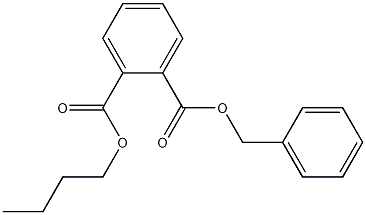Butyl benzyl phthalate cas no:85-68-7
Synonyms: 1,2-Benzenedicarboxylic acid butyl phenylmethyl ester; Butyl phenylmethyl 1,2-benzenedicarboxylate; Benzyl butyl phthalate; Butyl benzyl phthlate; BBP
NameButyl benzyl phthalate
CAS85-68-7
Synonyms1,2-Benzenedicarboxylic acid butyl phenylmethyl ester; Butyl phenylmethyl 1,2-benzenedicarboxylate; Benzyl butyl phthalate; Butyl benzyl phthlate; BBP
EINECS(EC#)201-622-7
Molecular FormulaC19H20O4
Molecular Weight312.36
Appearancecolourless oily liquid
refractive indexn20/D 1.54(lit.)
storage tempKeep in a cool, dry, dark location in a tightly sealed container or cylinder. Keep away from incompatible materials, ignition sources and untrained individuals. Secure and label area. Protect containers/cylinders from physical damage.
Globally Harmonized System of Classification adn Labelling of Chemicals(GHS)
Hazardclass9
Hazard T:Toxic;N:Dangerousfortheenvironment;
Risk R50/53;R61;R62
Safety
Questionable carcinogen with experimental carcinogenic data. Moderately toxic by ingestion, skin contact, and intraperitoneal routes. Experimental reproductive effects. Combustible when exposed to heat or flame; can react with oxidizers. To fight fire, use spray or mist, CO2, dry chemical. When heated to decomposition it emits acrid smoke and irritating fumes.
Hazard Codes:  T,
T, N
N
Risk Statements: 61-50/53-62
R61:May cause harm to the unborn child.
R50/53:Very toxic to aquatic organisms, may cause long-term adverse effects in the aquatic environment.
R62:Risk of impaired fertility.
Safety Statements: 53-45-60-61
S53:Avoid exposure - obtain special instructions before use.
S45:In case of accident or if you feel unwell, seek medical advice immediately (show the label whenever possible.)
S60:This material and its container must be disposed of as hazardous waste.
S61:Avoid release to the environment. Refer to special instructions / safety data sheets.
RIDADR: UN 3082 9/PG 3
WGK Germany: 2
RTECS: TH9990000
HazardClass: 9
PackingGroup: III
HS Code 29173400
| Organism |
Test Type |
Route |
Reported Dose (Normalized Dose) |
Effect |
Source |
| guinea pig |
LD50 |
oral |
13750mg/kg (13750mg/kg) |
BEHAVIORAL: SOMNOLENCE (GENERAL DEPRESSED ACTIVITY)
BEHAVIORAL: WITHDRAWAL |
Gigiena Truda i Professional'nye Zabolevaniya. Labor Hygiene and Occupational Diseases. Vol. 24(3), Pg. 25, 1980. |
| mouse |
LD50 |
intraperitoneal |
3160mg/kg (3160mg/kg) |
|
EHP, Environmental Health Perspectives. Vol. 4, Pg. 3, 1973. |
| mouse |
LD50 |
oral |
4170mg/kg (4170mg/kg) |
|
IARC Monographs on the Evaluation of Carcinogenic Risk of Chemicals to Man. Vol. 29, Pg. 193, 1982. |
| mouse |
LD50 |
skin |
6700mg/kg (6700mg/kg) |
|
Gigiena i Sanitariya. For English translation, see HYSAAV. Vol. 39(6), Pg. 25, 1974. |
| mouse |
LD50 |
unreported |
13700ug/kg (13.7mg/kg) |
|
Gigiena Truda i Professional'nye Zabolevaniya. Labor Hygiene and Occupational Diseases. Vol. 32(7), Pg. 52, 1988. |
| rabbit |
LD50 |
skin |
> 10gm/kg (10000mg/kg) |
|
Toxicology and Industrial Health. Vol. 3, Pg. 79, 1987. |
| rat |
LD50 |
oral |
2330mg/kg (2330mg/kg) |
|
IARC Monographs on the Evaluation of Carcinogenic Risk of Chemicals to Man. Vol. 29, Pg. 193, 1982. |
| rat |
LD50 |
skin |
6700mg/kg (6700mg/kg) |
|
Gigiena i Sanitariya. For English translation, see HYSAAV. Vol. 39(6), Pg. 25, 1974. |


 T,
T, N
N